Theory
To access the theory articles with the ChessBase Reader you must once again
use “Open – Database” in the “File” menu.
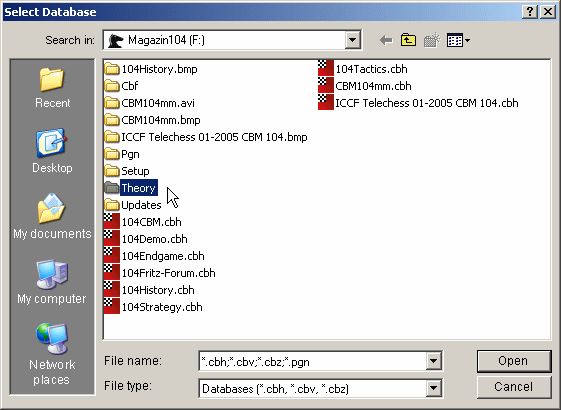
In the file selector you will see a number of subdirectories, one of which
is called “Theory”. Double-click this one and you will see its
contents: eight articles which we will discuss briefly below. Double-clicking
on any one of them will open it, revealing its contents.
The theory article is automatically displayed when you open the database.
The text contains links to games, lists or keys, each of which can loaded by
clicking on the links. There is also a “Games” tab on the top which
takes you to the database that is attached to the article.
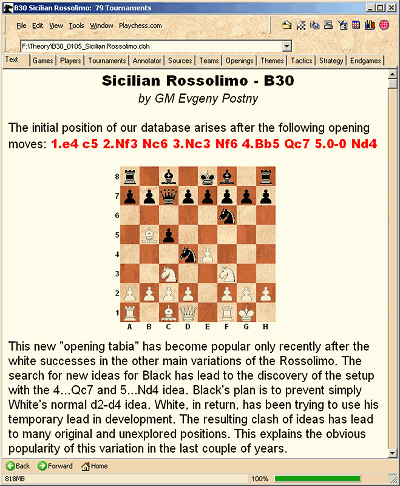
A69: Modern Benoni
The article on the Modern Benoni Three Pawns Attack begins after the moves
1.d4 Nf6 2.c4 g6 3.Nc3 Bg7 4.e4 d6 5.f4 0-0 6.Nf3 c5 7.d5 e6 8.Be2
exd5 9.cxd5 Re8 10.e5 dxe5 11.fxe5 Ng4.
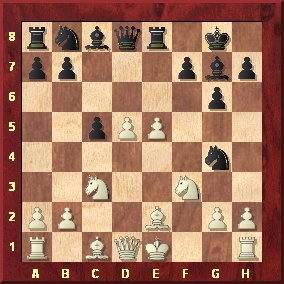
“After these moves we have a well known position,” writes Jerzy
Konikowski. “The main line begins with 12.Bg5. I will take a
look at an interesting gambit after 12.0-0!?. This continuation
is well worth considering and probably remains playable. Unlike after the move
12.Bg5, White is trying to fight for an advantage gradually. Here, an important
role is played by the passed pawn on d5 (d6), which can often very successfully
tie down the black forces and even fight its way through to the queening square
d8. My judgement: a sharp and complicated variation which offers White good
chances, especially if Black is surprised by the continuation 12.0-0!?. However,
with accurate play, Black has many good possibilities to defend successfully.”
The accompanying database contains 37 games, 19 with annotations, and four
openings surveys.
B30: Sicilian Rossolimo
This article by GM Evgeny Postny deals with the position
that arises after the following opening moves: 1.e4 c5 2.Nf3 Nc6 3.Nc3
Nf6 4.Bb5 Qc7 5.0-0 Nd4.
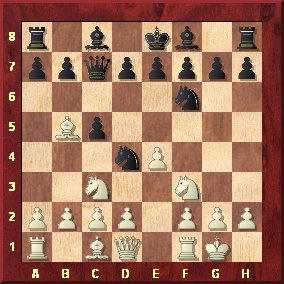
The author writes: This new “opening tabia” has become popular
only recently after the white successes in the other main variations of the
Rossolimo. The search for new ideas for Black has lead to the discovery of
the setup with the 4...Qc7 and 5...Nd4 idea. Black’s plan is to prevent
simply White’s normal d2-d4 idea. White, in return, has been trying to
use his temporary lead in development. The resulting clash of ideas has lead
to many original and unexplored positions. This explains the obvious popularity
of this variation in the last couple of years.
Obviously, the fact that several “Linares luminaries” have used
this variation has added to its credibility. Specifically the game Kasparov-Leko
from Linares 2003, in which Leko successfully neutralized Kasparov's attacking
ambitions, was instrumental in the variation's popularity. Several strong grandmasters
have adopted this variation for Black on a regular basis, such as van Wely,
McShane, Nakamura, Eljanov and many others.
There are 90 selected games in our database, 20 of them are annotated by
the author especially for this database (at least the opening part). Also included
are a few more games annotated by other ChessBase experts. This database contains
almost all fresh practical material – up to the end of December 2004.
There is also an opening key, especially developed for the current database.
Statistics for this database: out of 90 games White won 32 games = 35%, 34
games were drawn = 39%, Black won 24 games = 26%. The average rating of White
players was 2487, their performance was 2545; the average for Black was 2515,
with a performance of 2451.
B33: Sveshnikov Sicilian
The basic position of the variation examined by GM Dorian Rogozenko
arises after the moves 1.e4 c5 2.Nf3 Nc6 3.d4 cxd4 4.Nxd4 Nf6 5.Nc3
e5 6.Ndb5 d6 7.Bg5 a6 8.Na3 b5 9.Bxf6 gxf6 10.Nd5 f5 11.Bd3 Be6 12.0-0 Bxd5
13.exd5 Ne7 14.Re1.

After Dortmund 2003, where Bologan surprised Kramnik with the rather rare
plan starting with 14.Re1, this line constantly increased its popularity. Kramnik
himself played this way with White against Leko in Monaco 2004 and achieved
a large advantage. The present line is especially popular on the high level,
for instance in the last year’s Olympiad in Calvià five games
were played with it (which is a lot for a particular variation in a single
competition), and it is worth mentioning that the Elo rating average of these
games was 2570.
By playing 14.Re1 White prepares the retreat of the bishop to f1 after Black’s
advance ...e4. Then he can choose (and sometimes combine) from no less than
3-4 (!) plans to attack the opponent’s pawn formation: on the queenside
with the help of a4 or c4, and in the center with the help of f3 or g4. Black
must try to use the relative vulnerability of the pawn d5 in order to arrange
his pieces well and achieve a good cooperation between them. In that case he
will be ready to meet White's intentions with active play.
After 14...Bg7 (the continuation 14...e4 15.Bf1 Bg7 leads by transposition
to the same positions) Black threatens to play 15...e4 and then take on b2,
so White has to choose between two possibilities: 15.Rb1 and 15.c3. A move
like 15.Bf1 has never been tried in practice, because White releases too early
the pressure from f5. In that case Black would have the additional possibility
to refrain from ...e4 for a longer time and instead play other moves first,
like for instance ...Ng6.
Rogozenko’s conclusion: During one and a half years since the line
with 14.Re1 started to gain constantly in popularity, black players kept improving
their defensive methods. In the main line 15.c3 0-0 16.Qh5 e4 17.Bf1 Re8 18.Rad1,
Krasenkow’s fresh idea 18...Ng6 (variation d3) certainly needs more practical
tests for the final conclusion, but in my opinion the pawn sacrifice is not
entirely justified. More realistic is 18...Rc8 (Variation d2), where White
didn't show any sensible advantage in practice yet. Also Kramnik’s “old”
18...Qc8 (Variation d1) remains a vital option, even if Black gets a slightly
inferior position after that.
The database provided by Rogozenko contains 38 games, 27 with annotations.
B85: Scheveningen Variation with 12.Bd3
GM Viktor Gavrikov looks at the line after the moves 1.e4
c5 2.Nf3 d6 3.d4 cxd4 4.Nxd4 Nf6 5.Nc3 e6 6.Be2 Be7 7.f4 0-0 8.0-0 a6 9.a4
Nc6 10.Be3 Qc7 11.Kh1 Re8. White has many possibilities, but the subject
of the article is the continuation 12.Bd3 Nb4 13.a5.

The bishop on d3 protects the c2-pawn and later on White plans to develop
initiative on the kingside, but first he prevents Black’s activity on
the queenside. Continuations:
13...Bd7. This move is a usual reply to White’s set-up,
but an interesting alternative is 13...e5. Black wants to clarify the situation
in the center, and now both 14.Nf3 exf4 15.Bxf4 Be6 (Veroci,Z-Dzevlan,M, ½-½)
and 14.fxe5 dxe5 15.Nf5 Bxf5 16.Rxf5 Qd6 (Pritchett,C-King,D, 1-0) seem quite
playable for him.
After 13...Bd7 White can choose between four main continuations: 14.Nb3,
14.Nf3, 14.Qf3 and 14.Qe1. In Velimirovic, D-Poluljahov,A, 0-1, 14.g4 was tried,
but after 14...Bc6 15.f5 d5 (15...exf5!?) 16.fxe6 fxe6 17.Nxe6 Qd7 Black has
adequate counterplay.
The author provides 86 games, almost half with commentary, and concludes:
“After 13.a5, the move 13...e5 deserves further investigation. Also in
the line 13...Bd7 14.Qf3, the advance 14...e5 permits a solution of Black's
opening problems. Perhaps the most dangerous move for the second player is
14.Qe1, when he must choose between 14...Nxd3 15.cxd3 Rac8 and 14... Rac8.
Very often it is preferable for him to meet the manoeuvre Be3-d4 with Bf6 instead
of Bf8.”
The database accompanying this article contains 86 games, 39 annotated, mostly
by the author.
C88: Ruy Lopez Anti-Marshall 8.h3
“What’s new in the Anti-Marshall” is the title of the article
by Sergey Klimov. In his CBM 99 survey he dealt with one of
the most popular systems of modern opening theory – the Anti-Marshall
1.e4 e5 2.Nf3 Nc6 3.Bb5 a6 4.Ba4 Nf6 5.0-0 Be7 6.Re1 b5 7.Bb3 0-0 8.h3
Bb7 9.d3.
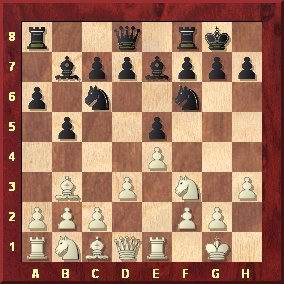
First of all Klimov draws our attention to the fact that lots of top players
include the Marshall (7...0-0 instead of 7...d6, “threatening”
to play 8...d5 after 8.c3) in their opening repertoire as Black, among them
is the great Ruy Lopez specialist GM Alexander Beliavsky.
The popularity of this line has even increased during the last months. Since
White still has real problems in getting an advantage in the Marshall Attack
itself, the Anti-Marshall with 8.h3 is one of the main topics in the opening
battle after 1.e4 e5. In the classical World Championship in Brissago, this
line was the main weapon of the pretender against 1.e4. Leko used it with good
results – Kramnik couldn’t get any real advantage out of the opening
in his games as White, not only in the 8.h3 line but in the Marshall itself
as well.
Klimov looks in critical detail at the different continuations and the influence
of contemporary games on their evaluation. His conclusion: “I am a bit
pessimistic about this line as White. In my opinion White should look for an
advantage in the main lines of the Marshall while this line promises him only
a theoretically small advantage if Black only plays for simplifications and
equality. There are some good ways for Black to get a complicated, double-edged
position. So it's White’s turn to prove his advantage.”
The attached database contains 33 games, 23 with commentary, mainly by the
author.
E05: Catalan
GM Zoltan Ribli looks at the position that arises after
the opening moves 1.d4 Nf6 2.c4 e6 3.g3 d5 4.Bg2 Be7 5.Nf3 0-0 6.0-0
dxc4 7.Qc2 a6 8.Qxc4 b5 9.Qc2 Bb7 10.Bd2 Be4 11.Qc1 Bb7 12.Bf4.
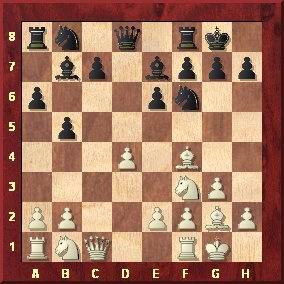
“Firstly,” he writes, “I would like to make two comments.
The bishop move 11...Bb7 (first played in the game Kasparov,G-Karpov,A 1984/85,
8th. match game) is actually an indirect offer of a draw, since by 12.Qc2 White
can repeat moves. And a technical tip: in some games White has played 11...Bb7
12.Qc2 Be4 13.Qc1 Bb7 14.Bf4, which, naturally, is of no independent importance,
but counts for two more moves in the game score.”
In the diagram, Black has two main continuations: 12...Bd6 and 12...Nd5.
A third continuation, 12...Nc6, has only been tried in the game Horvath,C-Brumen,D,
½-½, when 13.Rd1 Nd5 14.Nc3 Nxf4 15.Qxf4 gave White a comfortable
position with a slight positional advantage (in the game the next move was
15.gxf4).
The conclusion of Ribli’s investigations are: “In my opinion
Black’s play after 10... Be4 and 11...Bb7 leads to positions in which
White risks nothing and usually gets a comfortable position, with a small but
lasting positional advantage. The advantage of the move 11.Qc1 is that in some
variations White can recapture the f4-bishop with his queen. In the variation
12...B6 both 13.Nc3 and 13.Nbd2 offer White chances for an opening advantage,
whereas after 12...Nd5 White can fight for an opening advantage either with
13.Nc3 or with 13.Rd1.
The attached database contains 22 games, all annotated by the author.
E14: Nimzo/Bogo Indian – the Kempinski line
GM Alik Gershon focuses on two positions, one arising from
the Bogo Indian: 1.d4 Nf6 2.c4 e6 3.Nf3 Bb4+ 4.Nbd2 0-0 5.a3 Bxd2+
6.Qxd2 d6 7.e3 b6 8.Be2 Nbd7 9.0-0 Bb7
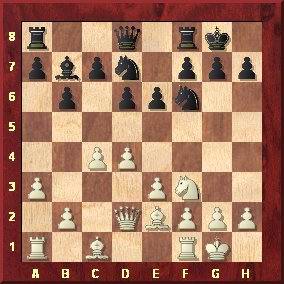
The second arose from a 4.Qc2 Nimzo, where White preferred to keep his bishop
on c1, rather than developing it to g5: 1.d4 Nf6 2.c4 e6 3.Nc3 Bb4
4.Qc2 0-0 5.a3 Bxc3+ 6.Qxc3 b6 7.Nf3 Bb7 8.e3 d6 9.Be2 Nbd7 10.0-0.
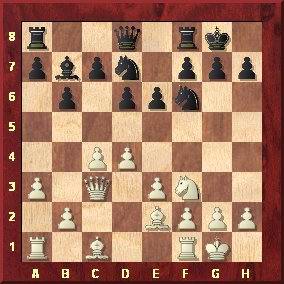
They are pretty much the same apart from a slight difference in the placement
of White's queen. However, there is also a less obvious difference: the side
to move. But despite the difference both positions are, of course, of the same
nature. White tries to seize hold of the center, placing his bishop pair behind
the pawns and slowly pushing Black backwards. Black, on the other hand, is
looking for counterplay on the kingside, exploiting his space advantage on
that part of the board and utilizing his strong light-squared bishop. Needless
to say that time is vital here, which explains the gap in results between the
two positions (53% with the tempo, and 47% without it).
Gershon’s conclusion: Whenever White has the tempo, his play is very
comfortable, and I believe it is not a coincidence that Black stopped opting
for this line. However, even with the tempo, Black should be careful, especially
when facing either Shipov or Matveeva. The area here is much less explored
than other 4.Qc2 Nimzo lines, and I will not be surprised if this is the next
fashion of the line. The attached database contains 38 games, 19 with sometimes
extensive annotations.
E97: King's Indian with 9 b4
GM Boris Avrukh looks at the popular line 10...f5 11 Ng5
Nf6 12 Bf3 c6. The main position of his database arises after the moves 1.d4
Nf6 2.c4 g6 3.Nc3 Bg7 4.e4 d6 5.Nf3 0-0 6.Be2 e5 7.0-0 Nc6 8.d5 Ne7 9.b4 Nh5
10.Re1 f5 11.Ng5 Nf6 12.Bf3 c6.
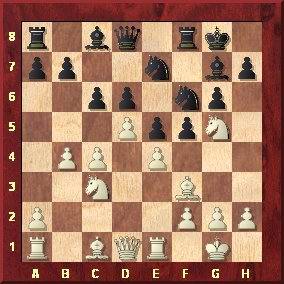
Avrukh writes: Even though the move 9.b4 has been known since the late 50s,
it was only in the mid-90s that this line became very popular. The responsibility
for this popularity lies exclusively with Vladimir Kramnik, who won many beautiful
games with it in the final decade of the past century. Nowadays this line is
extremely popular (in my opinion the most popular line against the King’s
Indian), and almost all top players who start with 1.d4 adopt it constantly
with White.
Of course, Black has found many interesting possibilities to make White’s
task difficult, but definitely the first player keeps slightly better chances
in all of them, except one which will be actually the topic of my article.
In his article Avrukh focuses on two recently very fashionable moves for
White, 13.Qb3 and 13.Bb2. Actually White has also tried 13.Be3 and 13.b5, but
here Black is doing fine according to the latest games. His conclusion at the
end of his investigation: both moves, 13.Qb3 and 13.Bb2, lead to very complicated
positions with a lot of hidden options for both sides. Black is doing quite
okay after 13 Qb3, the line 13...h6 14.Ne6 Bxe6 15.dxe6 fxe6 16.Ne4 Nf5 looks
perfectly playable for him. However, after 13.Bb2 the second player has serious
problems after the following supernovelty by Shirov:
Shirov,Alexei (2736) – Radjabov,Teimour
(2656) [E97], XXI SuperGM Linares ESP (6), 25.02.2004: 1.d4 Nf6 2.c4
g6 3.Nc3 Bg7 4.e4 d6 5.Be2 0-0 6.Nf3 e5 7.0-0 Nc6 8.d5 Ne7 9.b4 Nh5 10.Re1
f5 11.Ng5 Nf6 12.Bf3 c6 13.Bb2 h6 14.Ne6 Bxe6 15.dxe6 fxe4 16.Nxe4 Nxe4 17.Rxe4
d5 18.cxd5 cxd5 19.Rxe5 Bxe5 20.Bxe5 Qb6.
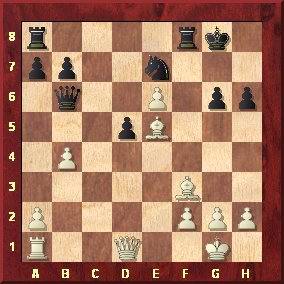
21.Bb2!N A novelty of very high level. Before this game
Black was doing very good in this line, but Shirov's novelty creates new problems
for Black, which Radjabov was unable to solve during this game, which ended
1-0.
There are 52 selected games in the accompanying database, 23 of them feature
commentary and 17 have been annotated by the author especially for this article.
The database includes all fresh material up to January 2005. You will also
find a deep opening key especially developed for this database.